Panettone from Italy
This dome-shaped sponge cake originates from Milan and is extremely popular not just in Europe but in several parts of the world. The recipe of this cake is similar to a sourdough and includes proofing thrice before being baked. While it is traditionally baked with raisins and candied fruits, people have come up with different versions and use dollops of chocolate and cream fillings to satisfy their taste buds.
Bibingka from Philippines
Bibinka is a kind of cake made from rice and coconut milk wrapped in banana leaves. The South-East Asian country is fond of Christmas and they express their love through their own unique Christmas cake. While Filiponos certainly are proud of this appetising cake, it is not restricted to the country itself and is equally popular among other Asian countries where Christmas is the craze.
La Bûche de Nöel from France
La Bûche de Nöel was made popular by French bakers in the 1900s and this kind of dessert is probably the first thing that springs to mind when one hears ‘Christmas cake’. Covered in chocolate or coffee buttercream that is textured to resemble tree bark, this spongecake—also called the yule log—has a highly distinctive log-like appearance. Log cakes are topped with meringue mushrooms, edible foliage, or sprinkled confectioner’s sugar.
Bolo Rei from Portugal
Like a king’s crown, the Bolo Rei, or King’s Cake, is circular with a hole in the middle and is covered in candied fruits and nuts. Its shape is ideal for its nomenclature. The cake is filled with dried fruits, candied fruits, and almonds to mimic a king’s crown. Originating in France, this classic Portuguese Christmas cake made its way to Portugal in the middle of the 1800s. Legend has it that the wise men once quarrelled over who should get the chance to present their gifts to baby Jesus. A fava bean was added to the Bolo Rei by a baker, and the person who would discover the bean in their piece of cake would be the one. It is now customary for the individual who discovers a fava bean in the slice of their cake to be the one paying for the cake next Christmas.
Pio Quinto from Nicaragua
With the addition of alcohol, the pio quinto is a hybrid of a cake and a custard. Typically dipped in rum as the preferred spirit, this cake is topped with layers of custard and sprinkled with cinnamon for an added burst of flavour.
Makowiec from Poland
Poland’s most beloved Christmas dessert is a kind of Swiss roll with a delicious filling and yeasted dough. Makoweic, which is filled with poppyseed, cheese, almonds, apples, or jam and flavoured with orange peel, offers a delicately balanced combination of salty and sweet flavours.
Kurisumasu keki from Japan
This sweet, light cake, which is made with whipped cream, fresh strawberries, and an airy sponge, is a popular decoration for store windows in the country throughout the month of December. Japanese Christmas cakes are works of art that are more a part of Japanese culture than Christmas itself, and they are likely one of the few cakes that depart from the customary, alcohol-soaked fruit cakes of Europe.
Gugelhupf of Vienna
A round, bundt shaped cake, Gugelhupf is popular across central Europe, especially Austria. Usually marbled, it is a staple across bakeries in Vienna. For Christmas, often flavours like mulled wine are integrated into the cake to make it a special treat.
Christstollen from Germany
Candied citrus peel, almonds, spices, dried fruit, and powdered sugar are all stuffed into this dense cake. It needs to rise and rest several times to achieve the ideal texture because of the amount of filling within, which can take up to four days.
This classic German fruit cake was first made during the Medieval fasting seasons in the 15th century. Even though the cake is now well-liked throughout Europe, the original recipe is still used today and is regarded as the authentic stollen-a type of bread.
